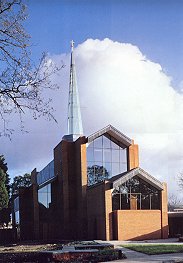
|
Thirty years on...
 Last summer (1997) I returned to Dulwich in south-east
London after thirty years, to revisit the place where I lived as a child. I had been a
treble in the choir of St Barnabas Church from 1964 until we moved to the
Nottingham-Derby area in 1967. In the summer of that year, when I was ten, the choirmaster
Raymond Gray had sent me on a Royal School of Church Music residential course at St.
Elphin’s School in Derbyshire. By strange coincidence our choirmaster Andrew Teague,
as you will know, is also now Head of Music at St Elphin’s.
Last summer (1997) I returned to Dulwich in south-east
London after thirty years, to revisit the place where I lived as a child. I had been a
treble in the choir of St Barnabas Church from 1964 until we moved to the
Nottingham-Derby area in 1967. In the summer of that year, when I was ten, the choirmaster
Raymond Gray had sent me on a Royal School of Church Music residential course at St.
Elphin’s School in Derbyshire. By strange coincidence our choirmaster Andrew Teague,
as you will know, is also now Head of Music at St Elphin’s.
Many people in the choir were kind to me (I remember one of the lady altos taking me to the Mermaid Theatre) and the influence of St Barnabas has endured. During my teenage years I was organist at a small church in Derbyshire, through which I met Gigi (my wife-to-be). After I moved back to Nottingham as a GP in 1985 I joined the choir here. I felt very much "at home" in our choir-stalls, but at first I did not realise why. I now appreciate that our nave is fourteenth century perpendicular, the style on which the St Barnabas that I knew was based, and our Victorian carved wooden chancel screen and choir stalls are contemporaneous with those I had known as a child. There was also a slightly wheezy organ just north of the chancel!
I speak of that church in the past tense because it was destroyed by fire in December 1992, just as the parishioners were preparing to celebrate its centenary. After considerable struggle by the Vicar and his PCC, a fine new church (equipped with an equally fine new organ) has been built to meet the needs of the next hundred years, and this was dedicated in October 1996.
There was a great sense of loss and desolation after the fire, and I too was upset when I heard that my childhood church had been destroyed. And yet, some good has come out of it. Firstly, thanks to William McVicker (the present organist) I was able to get in touch with Ray Gray and let him know of the debt of gratitude that I owed him before he died in 1995.
Secondly I have been reminded that although buildings are important, they are not as important as the people who use them. What would I have found if I had returned to the old St Barnabas? A building familiar yet strange, changed by physical alteration and fallible memory? A young solemn-faced ghost, sitting in the Decani choir stalls or watching the organist at his console? Instead, when I revisited the church last August I found a living, welcoming and witnessing Christian community, similar in many ways to St. Peter’s. Like us, they are an outward-looking urban church with a multi-racial congregation, trying to preserve its Anglican musical heritage. I felt very much "at home" with them, and was delighted to find at least one parishioner who remembers my family across that gap of thirty years.
Their new building is remarkable. Set among the palpable ruins of the old, its masses of red brick recall the previous architecture while its large areas of glass are open to the world, to which it extends an invitation to share the sacrament. My correspondents on the Internet tell me that certain Dulwich residents find the illuminated spire an eyesore and out of keeping with the character of the village. But to misquote Matthew 5:14, they "are light for all the world. A spire that stands on a hill cannot be hidden". And as I sat among the congregation during the service I caught a glimpse of my ghost, riding his bicycle up and down the grass on the north side of the church and playing with his fellow choirboys. He looked very happy, and I did not disturb him.
St Barnabas web site
St Barnabas Church, Dulwich, London
Return to the Articles contents page
http://www.stpetersnottingham.org/misc/barnabas.htm
© St Peter's Church, Nottingham
Last revised 31st January 1998